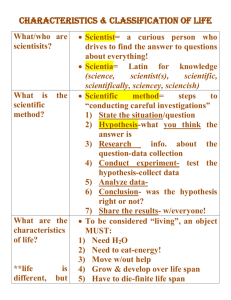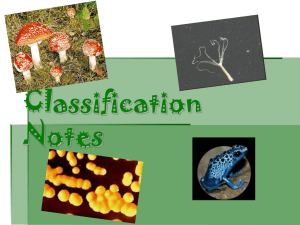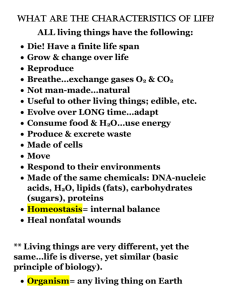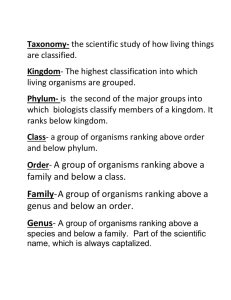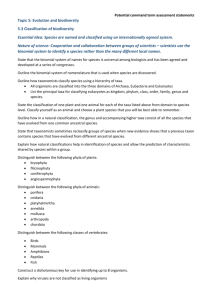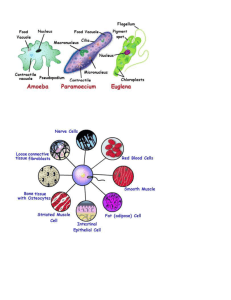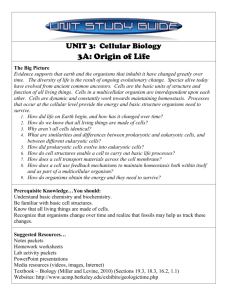What ALL living things have in common
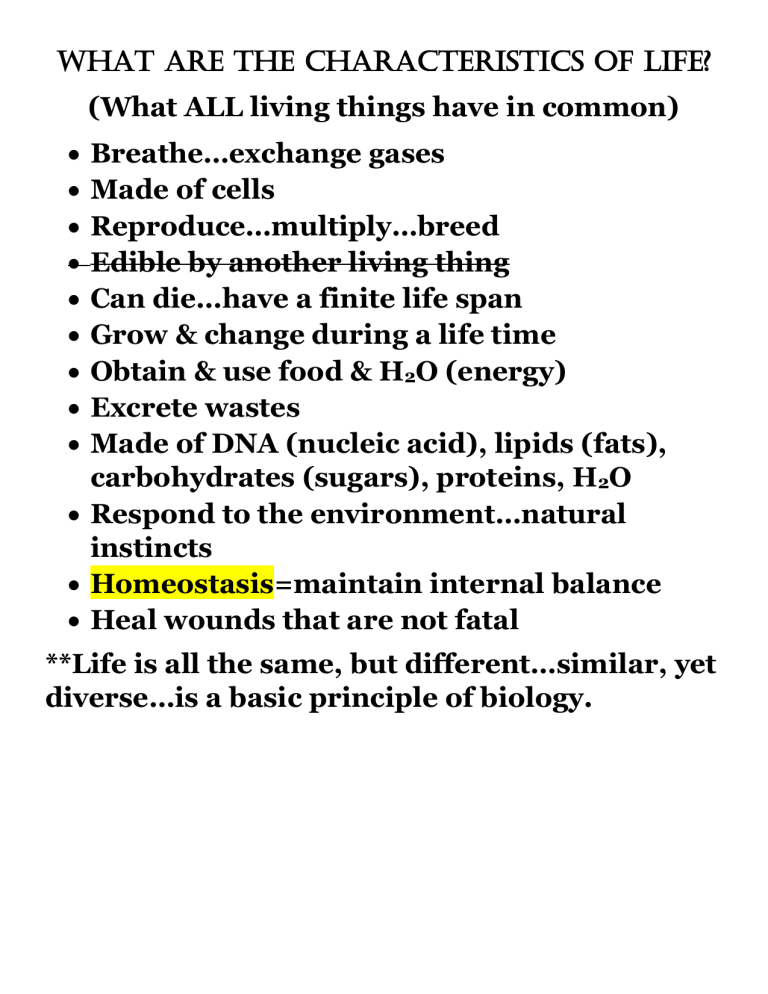
What are the Characteristics of life?
(What ALL living things have in common)
Breathe…exchange gases
Made of cells
Reproduce…multiply…breed
Edible by another living thing
Can die…have a finite life span
Grow & change during a life time
Obtain & use food & H
2
O (energy)
Excrete wastes
Made of DNA (nucleic acid), lipids (fats), carbohydrates (sugars), proteins, H
2
O
Respond to the environment…natural instincts
Homeostasis=maintain internal balance
Heal wounds that are not fatal
**Life is all the same, but different…similar, yet diverse…is a basic principle of biology.
How is life classified?
Living things are classified into groups based on similarities to make them easier to study
First three criteria used to classify an organism:
1) # of cells: unicellular=one cell only OR multicellular= more than one cell
2) Cell type: prokaryote=NO nucleus so DNA floats freely…only unicellular & very simple organisms OR eukaryote= DNA is inside a nucleus…both uni & multicellular…simple to very complex organisms
3) How get food:
Organisms that HUNT for food= heterotroph
…animals!
Organisms that MAKE own food= autotroph
…plants!
Taxonomy= study of the classification of organism…taxonomist=someone who does taxonomy
What are the levels of the modern classification system?
1) DOMAIN= 3 based on cell type
Bacteria-prokaryotic
Archaea (ancient bacteria)-prokaryotic
Eukarya- eukaryotic cells
2) KINGDOM= 4 in the eukaryotic domain
Protists (Protista)…unicellular, eukaryotic, no cell wall, auto or heterotroph…sea weed (brown algae)/kelp, amoeba, paramecium
Plant (Plantae)…multicellular, eukaryotic, cell wall , autotroph
Fungi…multicellular, eukaryotic, heterotroph, cell wall…mushrooms, mold, yeast
Animal (Animalia)…multicellular, eukaryotic, heterotroph, no cell wall
3) PHYLUM (phyla=1+)
2 plant kingdom phyla…vascular & non vascular
9 animal kingdom phyla…vertebrate + 8 invertebrate
4) CLASS
3 vascular plant classes…angiosperm, gymnosperm & fern
5 vertebrate animal classes…reptile, birds, mammals, amphibians, fish
5) ORDER:+++orders in e@ class
6) FAMILY: +++families in e@ order
7) GENUS: ++ genera in e@ family
8) SPECIES: ++species in e@ genera
=1 type of specific organism...can mate & produce fertile offspring (babies can have babies!)…can be a lot of variety among the species, EX: dog breeds & humans
*the more levels of classification 2 organisms share, the more closely related they are. **
What did I learn from the video, “Animal Classification?”
3.5 million+ identified organisms
Aristotle created 1 st classify system
Latin language Nevers changes, that is why classification is in Latin
Linnaeus created modern classification system in 1750’s
Linnaeus changed his name to Latin b/c he loved it so much…(karl von linne)
Classification is used everyday
Binomial nomenclature = a two word name for an organism (genus & species)
Classification is not a perfect science b/c constantly changing
Horses & donkeys can mate to create a mule, a hybrid animal
Mules can’t have babies so it is NOT a species
Cryptozoologist=scientist who searches for new species of organisms
Kids pick candy over fancy green salads=pneumonic device to remember the order of the levels
What is binomial nomenclature?
Binomial nomenclature= naming system of classification; two word name for an organism
First word names the genus level of the organism
Second word is the specific epithet which tells a characteristic of the organism
BOTH words name a single species
first word is capitalized, second word is not!...written in italics!
AKA scientific name
In Latin b/c this language never changes…dead language
(diagram)
What are hybrid organisms?
Hybrid organism= offspring of two closely related, but different species
Most can NOT reproduce…are infertile
NOT a new species b/c it is infertile
Parent organisms must share up to the genus level to make this possible
Mule (donkey X horse), tigon (tiger x lion), liger (lion x tiger), geep (goat x sheep), grolar bear (grizzly x polar), cama (camel X llama)
Humans create them (forced breeding) BUT some do happen naturally like the grolar bear
How do I “fix” my test for a passing grade?
D or F grade can be changed to a C grade
MC format: write the correct answer as a statement adding, “NOT (the incorrect choice you made)
EX: #9
The unique two word name for an organism is binomial nomenclature AKA scientific name,
NOT binomial nomenclature AKA nom de plume.
T/F format: write “It is false that (statement).
(Correct the statement, with elaboration, to make it true) OR “It is true that (statement for the test).
EX: #12
It is false that the characteristic usually missing in hybrid organisms is the ability to exchange gases. The characteristic missing in hybrids is the ability to reproduce. A hybrid is created by crossing two closely related, but different species.
